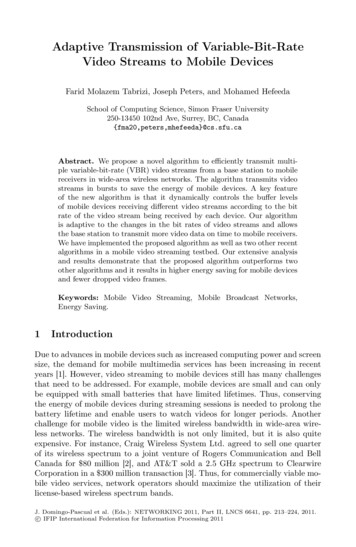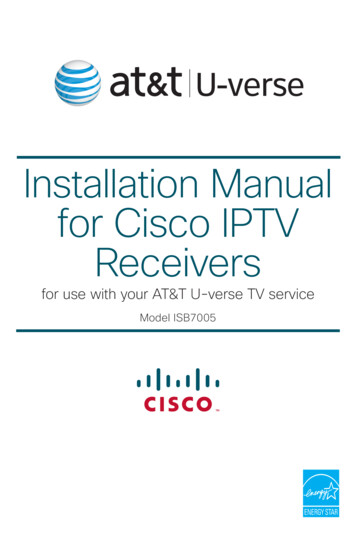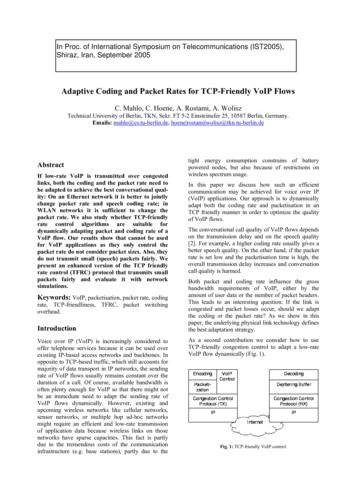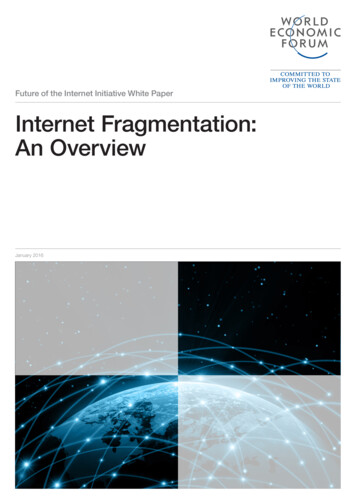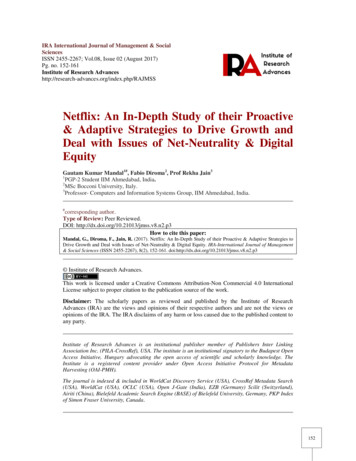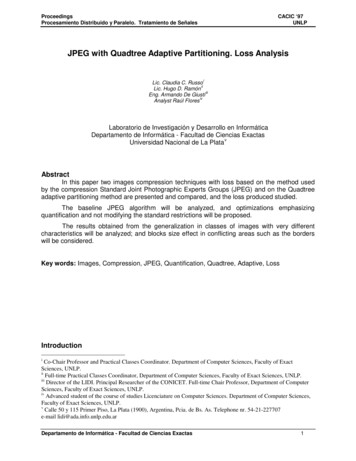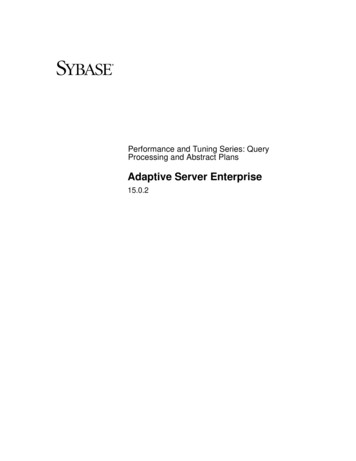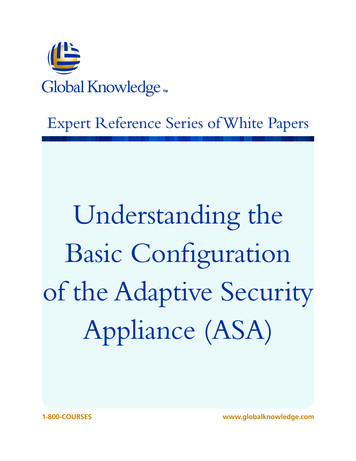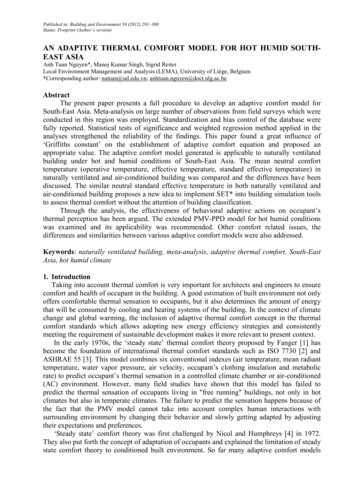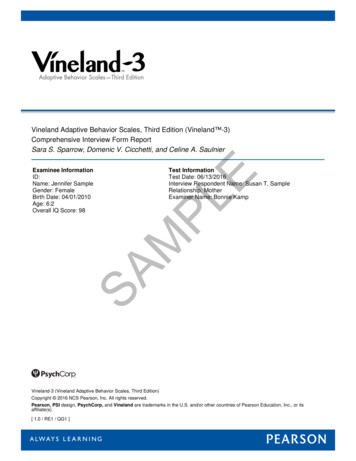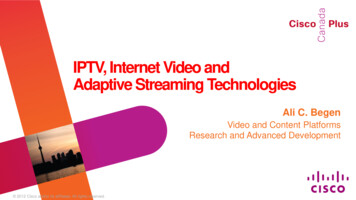
Transcription
IPTV, Internet Video andAdaptive Streaming TechnologiesAli C. BegenVideo and Content PlatformsResearch and Advanced Development 2012 Cisco and/or its affiliates. All rights reserved.
Presenter Today – Ali C. Begen Have a Ph.D. degree from Georgia Tech With Cisco since 2007Video and Content PlatformsResearch & Advanced Development Group Works in the area ofArchitectures for next-generation videotransport and distribution over IP networks Interested inNetworked entertainmentInternet multimediaTransport protocolsContent distribution Member of the IEEE and ACM Visit http://ali.begen.net for publications 2012 Cisco and/or its affiliates. All rights reserved.Cisco Public3
Agenda Part I: IPTVIPTV – Architecture, Protocols and SLAsVideo Transport in the Core NetworksVideo Distribution in the Access NetworksImproving Viewer Quality of Experience Part II: Internet Video and Adaptive StreamingExample Over-the-Top (OTT) ServicesMedia Delivery over the InternetAdaptive Streaming over HTTP 2012 Cisco and/or its affiliates. All rights reserved.Cisco Public4
Part I: IPTV 2012 Cisco and/or its affiliates. All rights reserved.
Consumers Seek A Rich Media Experience 2012 Cisco and/or its affiliates. All rights reserved.Cisco Public6
What Is IPTV?The Fundamental Component for Connected HomesIPTV IP Network-delivered Television- Switched digital video (SDV)- Video recording (DVR/PVR/nDVR)- Video-on-demand (VoD)- Interactive TV applications- Targeted (advanced) advertisingBroadbandIP Access 2012 Cisco and/or its affiliates. All rights reserved.Cisco Public7
Growth for IPTVIPTV Subscribers (Million)160140APACEMEA120North 5Source: Infonetics Research, 2011 2012 Cisco and/or its affiliates. All rights reserved.Cisco Public8
Trends Driving IPTV Adoption Subscribers want more choice and controlNew generation grew up computer/Internet savvyCustomized for me – One bill, one provider, integrated services Codec, access, server and CPE technologies are improvingMPEG-4 AVC (H.264) improvements, new xDSL, FTTx, DOCSIS 3.0 access technologiesMoore’s law advancements in processing and memory Competition is increasing among service providersNo longer limited by accessTraditional markets are going away, e.g., VoIP is almost freeVideo is driving next generation service provider network designs 2012 Cisco and/or its affiliates. All rights reserved.Cisco Public9
IPTV – Architecture, Protocols and SLAs 2012 Cisco and/or its affiliates. All rights reserved.
End-to-End IPTV Network ArchitectureSuper Headend (SHE)Video Hub Office (VHO)Regional Headend (RHE)Video SwitchingOffice AcquisitionAd InsertionVoD ServersTranscodersBack reamersVoD ServersCA/DRMIPTV rsIPTV rCoreSTBSTBSTBSTBDistribution/Aggregation 2012 Cisco and/or its affiliates. All rights NetworkMetro Aggregation &Distribution NetworkIP/MPLSCore NetworkMetroEthernetSTBAccessCisco PublicHome11
Unicast vs. MulticastUnicastSourceMulticastSource 2012 Cisco and/or its affiliates. All rights reserved.Cisco Public12
Broadcast IPTV IP Multicast Various TransportsNative IP multicast, MPLS, L2, optical SSM: Source-Specific Multicast (RFC 4604 and 4607)Receivers subscribe (S,G) channels to receive traffic only from source S sent to group GPrimarily introduced (by IETF) for IPTV-like services IP Multicast EndpointsSources: Encoder, transcoder, groomer, ad-splicerReceivers: Transcoder, groomer, ad-splicer, eQAM, IP STB IETF standardizedReceiver-to-Router Protocols: IGMPv3 (IPv4) and MLDv2 (IPv6) with (S,G) signalingRouter-to-Router Protocols: PIM-SSM, IGMPv3 Proxy Routing, Snooping on HAG and L2 devices Transport ChallengesPacket loss, out-of-order delivery, packet duplication(We cannot use TCP for IP multicast) 2012 Cisco and/or its affiliates. All rights reserved.Cisco Public13
Real-Time Transport Protocol (RTP)http://tools.ietf.org/html/rfc3550 BasicsFirst specified by IETF in 1996, later updated in 2003 (RFC 3550)Runs over any transport-layer protocol (Typically over UDP)Runs over both unicast and multicastNo built-in reliability Main ServicesPayload type identificationSequence numberingTimestamping ExtensionsBasic RTP functionality uses a 12-byte headerRFC 5285 defines an RTP header extension mechanism Control Plane – RTCPProvides minimal control and identification functionalityEnables a scalable monitoring functionality (Sender, receiver, extended reports) 2012 Cisco and/or its affiliates. All rights reserved.Cisco Public14
RTP Transport of MPEG2 Transport StreamsReligionPoliticsApplicationIPTV UDPIGMPIPNetworkData LinkPhysical 2012 Cisco and/or its affiliates. All rights reserved.Cisco Public15
Packetization into MPEG2 Transport StreamsSingle Program Transport Streams (SPTS)PacketizerAudioEncoderPacketizerAdditional Audio TracksApplication DataAudioPESMPEG2-TS MuxVideoVideoEncoderAudioVideoPESSPTSPAT (PID 0), ESDepacketizerVideoSPTSMPEG2-TS DemuxVideoPESAdditional Audio TracksApplication DataPAT (PID 0), PMT 2012 Cisco and/or its affiliates. All rights reserved.Cisco Public16
RTP Transport of MPEG2 Transport Streamshttp://tools.ietf.org/html/rfc2250V 2P XCCMPTSequence NumberTimestamp.Synchronization Source (SSRC) IdentifierN 188-byte MPEG2-TS Packets.MPEG2-TS PayloadContributing Source (CSRC) Identifiers RTP EncapsulationRTPMPEG2-TS Payload8 bytesUDP EncapsulationUDPRTPMPEG2-TS Payload20/40 bytesIP EncapsulationIPUDPRTPMPEG2-TS PayloadDefault IP header size is 20 and 40 bytes for IPv4 and IPv6, respectively 2012 Cisco and/or its affiliates. All rights reserved.Cisco Public18
Telco IPTV System Reference ntDeliverySystemCA/DRMCore T/ModemIP STBCA/DRMSystemIP Content and Delivery over Fiber/xDSL Access 2012 Cisco and/or its affiliates. All rights reserved.Cisco Public21
Cable IPTV System Reference ntDeliverySystemCA/DRMCore NetworkInternetVideoHeadendCMTSHFCCableModemIP STBCA/DRMSystemIP Content and Delivery over DOCSIS (VDOC) 2012 Cisco and/or its affiliates. All rights reserved.Cisco Public22
Efficiency Gains From IPTV in Cable DeliveryVariable Bitrate VBR provides a bandwidth savings of 40-60% IPTV is the best choice for narrowcast statmux and AVC statmuxSwitched Video Switching is the way to offer unlimited channels IPTV provides built-in switching functionalityAdvanced Coding AVC provides a bandwidth savings of 50% over MPEG2 IPTV solves the problem of slow channel changeQAM Sharing Convergence provides further bandwidth savings We can share QAMs for VoD and SDV as well as for video and DOCSIS 2012 Cisco and/or its affiliates. All rights reserved.Cisco Public23
Types of Video Services Transport (Contribution and Primary Distribution) IPTV /CATV (Secondary Distribution)IP multicast distribution from centralized super headendsDriving enhanced multicast features and functions VoD (Secondary Distribution)Distributed architecture for better scalabilityNon-real-time content distribution to caches EnterprisemVPN basedDriving enhanced multicast features and functions Over-the-Top (e.g., Hulu, Apple TV, Netflix)Adaptive streaming methods are quickly becoming ubiquitous 2012 Cisco and/or its affiliates. All rights reserved.Cisco Public24
IPTV must Deliver Entertainment-Caliber VideoTolerance is One Visible Artifact per s)IP/MPLSCoreReliability is moreAccessNational ContentRegionalHeadend(x10s)AcquisitionRegional ContentVideoSwitching Office(x100s)EncodersAcquisitionAd InsertionVaultEncodersBack Office/BillingStreamersVoD Serversdifficult to achieve hereStreamers 2012 Cisco and/or its affiliates. All rights reserved.Cisco Public26
Taxonomy of Video Service ProvidersHigher BandwidthStudio to StudioUncompressed/Lossless compression- SD: 270 Mbps (SMPTE 259M)- HD: 1.5 – 3 Gbps(SMPTE 292M, 372M, 424M)P-to-P P-to-MpContributionProvider to SubscriberCompressed- SD: 2 – 6 Mbps- HD: 6 – 16 MbpsP-to-P for VoDP-to-Mp for IPTVMay be Owner to ProviderCompressed (High quality)P-to-P P-to-MpStricter Requirements 2012 Cisco and/or its affiliates. All rights reserved.Cisco Public27
Video SLA Requirements ThroughputAddressed through capacity planning and QoS (i.e., Diffserv) Delay/JitterControlled with QoSAbsorbed by de-jittering buffer at IP STBWe desire to minimize jitter buffer size to improve responsivityJitter originating in the core is rather insignificant Packet LossControlling loss is the main challenge Service AvailabilityProportion of time for which the specified throughput is available within thebounds of the defined delay and loss 2012 Cisco and/or its affiliates. All rights reserved.Cisco Public29
Video Transport in the Core Networks 2012 Cisco and/or its affiliates. All rights reserved.
Four Primary Causes for Packet Loss Excess DelayRenders media packets essentially lost beyond an acceptable boundCan be prevented with appropriate QoS (i.e., Diffserv) CongestionConsidered as a catastrophic case, i.e., fundamental failure of serviceMust be prevented with appropriate QoS and admission control PHY-Layer ErrorsApply to core and access – Occurrence in core is far lessConsidered insignificant compared to losses due to network failures Network Reconvergence EventsOccur at different scales based on topology, components and trafficCan be eliminated with high availability (HA) techniques 2012 Cisco and/or its affiliates. All rights reserved.Cisco Public31
What are the Core Impairment Contributors?Impairment RateTrunk failures.0010 /2hHardware failures.0003 /2hSoftware failures.0012 /2hNon-stop forwarding (NSF) andStateful switch-over (SSO) help hereSoftware upgrades (Maintenance).0037 /2hModular code (IOS-XR) helps hereTotal.0062 /2h(One every two weeks)Note that average mean time between errors on a DSL line is in the order ofminutes when no protection is appliedBack of envelope calculations across several SPs showmean time between core failures affecting video is 100 hoursSource: Data from industry standards, customers and assumptions 2012 Cisco and/or its affiliates. All rights reserved.Cisco Public32
Unequal Importance of Video PacketsIPBBPBBPBB – MPEG GoPPBBPPIBB 2012 Cisco and/or its affiliates. All rights reserved.BBCisco Public33
MPEG Frame Impact from Packet LossGoP Size: 500 ms (I:P:B 7:3:1)I-Frame Loss Probability (%)10080FUD on 50-ms Requirement- Legacy telco voice requirement60- Artifact of SONET/SDHFACTS- IP multicast is UDP based40- The only acceptable loss is 0%- At 50 ms outage, an I-frame will20be impacted with a chance of 34%050100150200250300350400Outage Duration (ms) 2012 Cisco and/or its affiliates. All rights reserved.Cisco Public45050055060035
Video SLA RequirementsNetwork ApproachesCost and Complexity- Fast convergence- Fast rerouteOver-engineered- Spatial diversity- Source diversityApplication ApproachesViableEngineering- Forward Error Correction (FEC)- Temporal diversityMust be re-engineeredLoss Occurrence 2012 Cisco and/or its affiliates. All rights reserved.Cisco Public41
Towards Lossless IPTV TransportReading“Toward lossless video transport,”IEEE Internet Computing, Nov./Dec. 2011“Designing a reliable IPTV network,”IEEE Internet Computing, May/June 2009 2012 Cisco and/or its affiliates. All rights reserved.Cisco Public43
Video Distribution in the Access Networks 2012 Cisco and/or its affiliates. All rights reserved.
VQE – A Unified QoE SolutionGlitch-Free Audiovisual Quality, Short and Consistent Zapping IPTV viewers have two criteria to judge their serviceArtifact-free audiovisual qualityLoss may be correlated in spatial and/or temporal domain, must be recoveredquicklyLoss-repair methods must be multicast friendlyShort and consistent zapping timesCompression and encryption used in digital TV increase the zapping timesMulticasting in IPTV increases the zapping times Service providers need a scalable unified solution thatIs standards-based and interoperable with their infrastructureEnables versatility, quick deployment and visibility into the networkExtends the service coverage area, and keeps CapEx and OpEx low 2012 Cisco and/or its affiliates. All rights reserved.Cisco Public45
A Simplified ModelVQE ClientRetransmission Server(w/ Feedback Target)STBVQE ServerVQE ClientTransport &DistributionAccessNetworkDSLAMSTBVQE ClientSTBAggregationRouterRTP SourceVQE ClientSTBVQE ClientChannel 1Channel 2DSLAMSTB Each TV channel is served in a unique (SSM) multicast sessionIP STBs join the respective multicast session for the desired TV channelRetransmission servers join all multicast sessions Unicast feedback from IP STBs are collected by the feedback targetNACK messages reporting missing packets, rapid channel change requestsRTCP receiver and extended reports reporting reception quality 2012 Cisco and/or its affiliates. All rights reserved.Cisco Public46
Packet Loss Rate Tolerance LimitsEach Random or Bursty Loss Counts for One Artifact 2012 Cisco and/or its affiliates. All rights reserved.Cisco Public47
Impairments in xDSL Networks Twisted pair is subject toSignal attenuation: Use shorter loopsCross talk: Use Trellis Coding and RS-based FECImpulse noise: Use RS-based FEC with interleaving There are three types of DSL impulse noiseREIN: Short burst of noises ( 1 ms)PEIN: Individual impulse noise ( 1 ms, 10 ms)SHINE: Individual impulse noise ( 10 ms) We observe different noise characteristicsAmong different SP networksAmong different loops in the same SP network 2012 Cisco and/or its affiliates. All rights reserved.Cisco Public48
First-Line of Defense in Loss Repair1-D/2-D Parity Forward Error Correction Source Block Size: D x LL23R1456R2789101112XORD1R3R4FEC Packets 1-D Column FEC (for Bursty Losses)Each column produces a single packetOverhead 1 / DL-packet duration should be larger than the(target) burst duration 1-D Row FEC (for Random Losses)Each row produces a single packetXOROverhead 1 / L 2-D Column Row FECC1C2C3Overhead (D L)/(DxL)FEC Packets 2012 Cisco and/or its affiliates. All rights reserved.Cisco Public53
First-Line of Defense in Loss Repair1-D/2-D Parity Forward Error CorrectionRetransmission Server(w/ Feedback Target)STBSTBTransport uterRTP SourceChannel 1FEC for Channel 1DSLAMSTB Each TV channel may be associated with one or more FEC streamsFEC streams may have different repair capabilitiesIP STBs may join the respective multicast sessions to receive FEC stream(s) General Remarks FEC scales extremely well with upfront planning, easily repairs spatially correlated losses Longer outages require larger overhead or larger block sizes (More delay) FEC requires encoding/decoding operations 2012 Cisco and/or its affiliates. All rights reserved.Cisco Public55
Second-Line of Defense in Loss RepairRTP RetransmissionsRetransmission Server(w/ Feedback Target)STBSTBTransport rRTP SourceChannel 1Feedback and retransmissions for Channel 1STBDSLAMSTB There is a (logical) feedback target for each TV channel on the retransmission serverIf optional FEC cannot repair missing packets, IP STB sends an RTCP NACK to report missing packetsRetransmission server pulls the requested packets out of the cache and retransmits them General Remarks Retransmission recovers only the lost packets, so no bandwidth is wasted Retransmission adds a delay of destination-to-source-to-destination Protocol suite comprises RFCs 3550, 4585, 4588 and 5760 2012 Cisco and/or its affiliates. All rights reserved.Cisco Public56
Improving Viewer Quality of Experience 2012 Cisco and/or its affiliates. All rights reserved.
TV Viewers Love ZappingResults are Based on 227K Users in NAMinMean726Std81490th Percentile167295th Percentile225099th Percentile3798Max 2012 Cisco and/or its affiliates. All rights reserved.Cisco Public12418658
Zappings are Correlated in Temporal DomainOn a Sunday between 8:00 – 9:00 PMNumber of Users Tuned80007000600050004000300001020 2012 Cisco and/or its affiliates. All rights reserved.30Time (Minutes)40Cisco Public506059
Delay Elements in Multicast MPEG2-TS Video Multicast Switching DelayIGMP joins and leavesRoute establishment (Generally well-bounded) Reference Information LatencyPSI (PAT/CAT/PMT) acquisition delayCAS (ECM) delayRAP acquisition delay Buffering DelaysLoss-repair, de-jittering, application bufferingMPEG decoder bufferingReference information latency and buffering delays aremore critical in MPEG-based AV applications 2012 Cisco and/or its affiliates. All rights reserved.Cisco Public60
Typical Zapping Times on DSL IPTVUnit TimeTotal TimeIP STB sends IGMP Leave 100 msIP STB sends IGMP Join 100 msDSLAM gets IGMP Leave 100 msDSLAM gets IGMP Join 100 ms 200 ms50 ms 250 msLatency on DSL line 10 ms 260 msIP STB receives PAT/PMT 150 ms 400 msDe-jittering buffer 150 ms 550 msWait for CA 50 ms 600 msWait for I-frame0–3s0.5 – 3.5 sMPEG decoding buffer1–2s1.5 – 5.5 s 50 ms1.5 – 5.5 sDSLAM switches streamsBufferingDecoding 2012 Cisco and/or its affiliates. All rights reserved.Cisco Public61
A Typical Multicast JoinTime the IP STB needs to waitto start processing multicast dataTimeMuRAPltic(1) JoinastDataRAPIP STBRAPs might be far away from each otherRAP data might be large in size and non-contiguous 2012 Cisco and/or its affiliates. All rights reserved.Cisco Public62
Concurrent Multicast Join and RetransmissionData the IP STB needs to getfrom the retransmission serverTimeMuRAPltic(1) JoinastDataRAP(1) Retransmission requestIP STB(2) Unicast retransmissionRetransmissionServerIf the residual bandwidth remaining from the multicast stream is small,retransmission may not be able to provide any acceleration 2012 Cisco and/or its affiliates. All rights reserved.Cisco Public63
Retransmission Followed by Multicast JoinData the IP STB needs to getfrom the retransmission serverTimeMultica(3) JoinRAPstDataRAP(1) Retransmission requestIP STB(2) Unicast retransmissionRetransmissionServerMore data are retransmitted due to deferred multicast joinHowever, IP STB ultimately achieves a faster acquisition 2012 Cisco and/or its affiliates. All rights reserved.Cisco Public64
Proposed SolutionUnicast-Based Rapid Acquisition IP STB says to the retransmission server:“I have no synch with the stream. Send me a repair burst that will get me back on the trackwith the multicast session” Retransmission serverParses data from earlier in the stream and bursts faster than real timeCoordinates the time for multicast join and ending the burst This solution uses the existing toolkit for repairing packet lossesRFC 3550 (RTP/RTCP)RFC 4585 (RTP AVPF)RFC 4588 (RTP Retransmissions)RFC 5760 (RTCP Extensions for SSM) 2012 Cisco and/or its affiliates. All rights reserved.Cisco Public65
Unicast-Based Rapid AcquisitionLeave Ch. XAcquisition request for Ch. YDecoder priming, join time, burst descriptionUnicast Burst 2012 Cisco and/or its affiliate
Customized for me – One bill, one provider, integrated services Codec, access, server and CPE technolo
